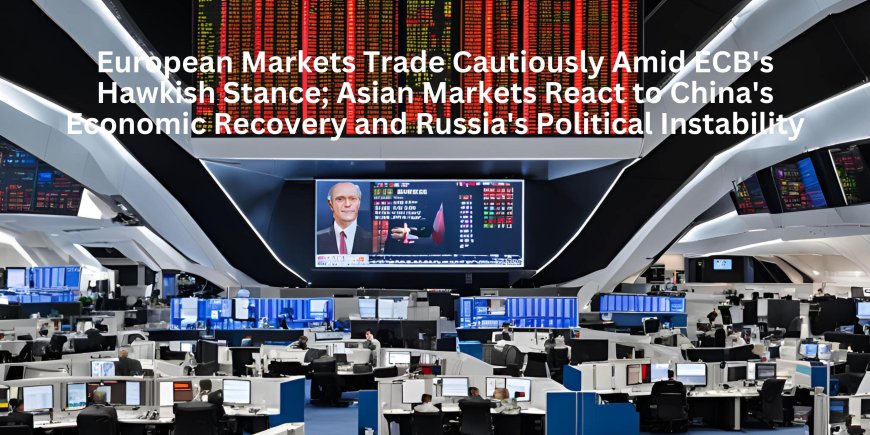European Markets Trade Cautiously Amid ECB's Hawkish Stance; Asian Markets React to China's Economic Recovery and Russia's Political Instability
European markets experience cautious trading due to the ECB's hawkish stance, while Asian markets react to China's uneven economic recovery and political instability in Russia. Discover how these factors influence global market trends and investor sentiment.

European Markets Experience Cautious Trading Amid ECB's Hawkish Stance
European markets have been characterized by cautious trading recently, primarily due to the European Central Bank's (ECB) increasingly hawkish stance. Investors are weighing the implications of potential tightening of monetary policy amidst concerns about inflation and economic stability. Meanwhile, Asian markets are reacting to China's uneven economic recovery and the political instability in Russia, adding to the global financial uncertainty.
ECB's Hawkish Stance and Its Impact
The ECB has signaled a shift towards a more hawkish monetary policy, suggesting that interest rates may be raised to combat rising inflation. This shift is a response to persistent inflationary pressures that have been affecting the Eurozone, driven by factors such as energy prices, supply chain disruptions, and increasing consumer demand as economies recover from the pandemic.
Key Points:
- Inflation Concerns: Inflation in the Eurozone has remained above the ECB's target, prompting the central bank to consider tightening measures. The latest data indicates that inflation rates have been persistently high, with core inflation also showing signs of rising.
- Interest Rate Hikes: The potential for interest rate hikes has created uncertainty in the markets. Higher interest rates could increase borrowing costs for businesses and consumers, potentially slowing down economic growth.
- Market Reaction: European equity markets have responded with cautious trading. Investors are concerned about the impact of tighter monetary policy on corporate profits and economic activity. Bond yields have also been rising in anticipation of higher interest rates, which has affected the bond markets.
Asian Markets React to China's Economic Recovery and Russia's Political Instability
In Asia, markets have been influenced by a combination of economic and geopolitical factors. China's economic recovery has been uneven, with some sectors showing strength while others lag. Additionally, political instability in Russia has added to the uncertainty, affecting investor sentiment across the region.
China's Economic Recovery:
- Mixed Signals: China's economic data has been sending mixed signals. While industrial production and export figures have shown growth, other indicators such as retail sales and property market activity have been weaker. This uneven recovery has raised concerns about the sustainability of China's economic growth.
- Policy Measures: The Chinese government has implemented various policy measures to support the economy, including fiscal stimulus and monetary easing. However, the effectiveness of these measures in addressing structural issues and sustaining long-term growth remains uncertain.
- Market Impact: Chinese equity markets have experienced volatility as investors react to the latest economic data and policy announcements. Concerns about regulatory crackdowns on tech companies and property developers have also weighed on market sentiment.
Political Instability in Russia:
- Geopolitical Risks: Political instability in Russia, driven by domestic unrest and international tensions, has created additional risks for global markets. The situation has implications for energy markets, given Russia's significant role as an energy exporter.
- Market Response: Asian markets have been sensitive to developments in Russia, with investors closely monitoring the potential impact on global energy prices and supply chains. Any escalation in political tensions could lead to increased volatility in the markets.
Global Market Trends and Investor Sentiment
The combination of these factors has created a complex environment for global markets. Investors are navigating a landscape marked by central bank policies, economic data, and geopolitical risks.
Key Trends:
- Cautious Optimism: Despite the challenges, there is a sense of cautious optimism among investors. Many believe that the global economy is on a path to recovery, albeit with some bumps along the way. This optimism is reflected in selective buying in sectors that are expected to benefit from economic reopening and growth.
- Sector Rotation: Investors are rotating into sectors that are seen as more resilient to interest rate hikes and economic uncertainties. These include technology, healthcare, and consumer staples, which have shown strong performance even during periods of market volatility.
- Risk Management: Managing risks has become a priority for investors. Strategies such as diversification, hedging, and focusing on quality stocks are being employed to navigate the uncertain environment.
Strategic Implications for Investors
Given the current market dynamics, investors are adopting various strategies to manage risks and capitalize on opportunities:
Diversification:
- Global Exposure: Diversifying investments across different regions can help mitigate risks associated with specific economic or geopolitical events. Exposure to both developed and emerging markets can provide a balance between growth potential and stability.
- Sector Allocation: Allocating investments across different sectors can help manage risks and take advantage of growth opportunities. Sectors such as technology, healthcare, and consumer goods are seen as more resilient in the current environment.
Risk Management:
- Hedging Strategies: Using hedging instruments such as options and futures can help protect portfolios from downside risks. These strategies can provide a cushion against market volatility while maintaining exposure to potential upside.
- Quality Focus: Focusing on high-quality stocks with strong fundamentals, stable earnings, and solid growth prospects can provide a buffer against market fluctuations. Companies with strong balance sheets and competitive advantages are likely to weather economic uncertainties better.
Monitoring Economic and Geopolitical Developments:
- Central Bank Policies: Keeping a close eye on central bank policies, particularly those of the ECB and other major central banks, is crucial for understanding potential impacts on interest rates and market conditions.
- Economic Data: Regularly monitoring economic indicators such as inflation rates, GDP growth, and employment figures can provide insights into the health of the global economy and inform investment decisions.
- Geopolitical Risks: Staying informed about geopolitical developments, particularly in regions such as China and Russia, can help investors anticipate potential risks and adjust their strategies accordingly.
Conclusion
European markets are experiencing cautious trading due to the ECB's hawkish stance, while Asian markets are reacting to China's uneven economic recovery and political instability in Russia. These factors are creating a complex and uncertain environment for global markets, influencing investor sentiment and driving strategic decision-making.
Investors are adopting a mix of cautious optimism and proactive risk management, focusing on diversification, quality stocks, and monitoring key economic and geopolitical developments. As the global economy continues to navigate these challenges, staying informed and adaptable will be key to achieving investment success in the months ahead.

 LD Web Desk
LD Web Desk 